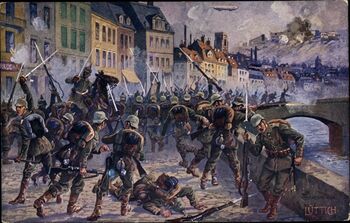First Battle of Trunly-Verne
| First Battle of Trunly-Verne | |||||||
|---|---|---|---|---|---|---|---|
| Part of the Northern Front of the Great Europan War | |||||||
 Illustration of Germanan troops storming the town of Verne. | |||||||
| |||||||
| Belligerents | |||||||
|
|
| ||||||
| Commanders and leaders | |||||||
|
|
| ||||||
| Units involved | |||||||
|
|
| ||||||
| Strength | |||||||
| 120,000 men deployed | 90,000 men deployed | ||||||
| Casualties and losses | |||||||
| 8,500 | 11,000 | ||||||
The First Battle of Trunly-Verne was a major early battle of the Great Europan War, perhaps one of the most important battles of the early war. The Germanan First Army under General Frederick, Graf von Deffelstaber broke through Belvanian defences around the towns of Trunly and Verne, taking eleven-thousand casualties in the attempt. The Belvanian First Army under Sir Bertram Howard was pushed back at the loss of 8,500 men, abandoning the forts surrounding the towns and allowing the Meier Plan to continue unhindered.
Background
Trunly and Verne, two towns on the River Lecker, represented the strongest obstacle facing the Germanan offensive against Dragovich. The two towns were located incredibly close to one another and were overlooked by strong fortifications. The River Lecker ran through both towns, forcing an attacker to cross the river before assaulting the forts. Germanan forces of the First Army under Frederick von Deffelstaber had turned back two Belvanian attacks and were now counterattacking as part of the Meier Plan, the ultimate goal of which being the capture of the port city of Dragovich and the destruction of large parts of the Belvanian and Molvanian armies. The plan required the Germanan forces to cross the Lecker and take the town of Helioberg. Trunly and Verne had enough bridges to move large portions of the Germanan army over the river swiftly. Also, the Trunly-Verne forts had to be neutralised otherwise the flanks of the Germanan offensive forces would be threatened badly.
Battle
Von Deffelstaber resolved to take the towns quickly before tackling the forts. Taken by surprise, the Belvanian defenders were unable to mine the bridges and the Germanan 4th Division took Verne almost without firing a shot as the defenders retreated upon their arrival. The 2nd and 3rd Divisions took heavy casualties capturing the Trunly bridges from Belvanian mortar and machinegun fire. The First Army spent three hours securing the towns while Von Deffelstaber brought up his heavy artillery to bombard the forts which had turned their own guns on his infantry. Without the time for a protracted siege, Von Deffelstaber bombarded the forts until the early hours of the 3rd when he sent his infantry in to clear the forts with bayonets and grenades. This decision was costly but effective, most of the forts were captured and the rest were soon abandoned.
Aftermath
The ease with which the forts of Trunly and Verne were taken essentially convinced the Germanan High Command that the day of the static fortification was over. Sir Bertram Howard's Belvanian First Army had been dealt its second decisive defeat in three weeks in addition to the many unsuccessful skirmishes that it had fought since the start of the war. Trunly-Verne was the first true disaster of the war, the fall of the forts essentually secured the fall of Helionberg, Belvania's sole naval base on the continent.
The Germanan army left a skeleton force to hold the forts following their capture and soon came to regret this decision when, at the Second Battle of Trunly-Verne, the forts were almost retaken and were held only at a tremendous cost.
